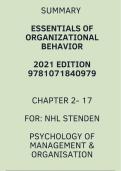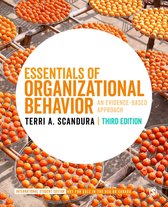,Must know everything in YELLOW for
exam!
1.Three components of attitudes
1. Cognitive
i.This is a description or belief about
Chapter 2 – Attitudes the ways things are, it sets the stage
for the next component.
i.Displays the emotional or feeling
2.Affective
segment of an attitude, this spawns
the next component.
i.This describes the intention to
behave in a certain way towards
3.Behavioural
someone or something
2. Relationship between attitudes and behaviour
1. Attitude follows behaviour, a person’s attitude towards someone or something
will change according to their behaviour. To reduce dissonance between what is
said and what is done.
(Attitude is a way of thinking,feeling, belief, or opinion of approval or
disapproval towards something. Behavior is an action or reaction that occurs in
response to an event or internal stimuli (i.e., thought).)
3. Comparison and relation between major job attitudes
1. Usually when people speak about attitude people mean Job satisfaction, this
means whether someone feels positively or negatively about his or her job.
2. Job involvement is the degree to which
a person identifies with a job, actively participates in it, and considers
performance important to their self-worth.
3. Psychological empowerment is employees’ beliefs regarding the degree to
which they influence their work environment, their competencies and the
meaningfulness of their job.
4. An employee with organizational commitment identifies with a particular
organization and its goals and wishes to remain a member. Emotional
attachment to an organization and belief in its values is the “gold standard” for
employee commitment.
5. Perceived organizational support is the degree that employees think that the
company cares about their well-being. The way this is valued and perceived is
heavily dependable on culture.
6. Employee engagement: An individual’s involvement with, satisfaction with,
and enthusiasm for the work he or she does.
4. Measure of job satisfaction
, 1. Job satisfaction is defined as a positive feeling about a job resulting from an
evaluation of its characteristics
2. There are two measures for job satisfaction
i. A single question rated 1-5:” all things considered, how satisfied are you
with your job?”
ii. The other measure is constructed of many different facets of job
satisfaction similarly rated as the previous one, then summation of
those results show the measure of satisfaction.
iii.Neither measure is more accurate than the other, the simpler one
however leaves time for open questions that could be of higher value to
the management.
5. Four employee responses to dissatisfaction
1. The responses of dissatisfaction a categorized in a matrix with four outcomes:
i. Exit. This response directs behaviour towards leaving the
company(active/destructive)
ii. Voice. Dissatisfaction expressed through active and constructive
attempts to improve conditions.
iii.Loyalty. This response means passively waiting for conditions to
improve, speaking up against external criticism and trusting the
management will do the right thing. (passive/constructive)
iv. Neglect. Employees that have this response, passively allow conditions
to worsen. They will have higher absenteeism or lateness, reduced
effort and increased error rate. (passive/destructive)
Chapter 3 – Emotions at Work
1. Differentiation between emotions and mood
1. Emotions and moods are captured under a generic term Affect
i. Emotions: intense feelings directed towards someone or something,
they are generally very brief in nature. Characterized by distinct facial
expressions, moreover can be identified as: anger, fear, sadness,
happiness etc.
ii. Moods: less intense feelings that arise without a specific event or
stimulus. They last longer than emotions, and are generally not
indicated by distinct expressions.
2. Are emotions rational and what function do they serve?
1. Brain research suggest that, one must be able to experience emotions to be
able to think rational.
2. Research show that emotions are vital to critical thinking
3. Validity of potential sources of emotions and moods
1. Personality, people have built in tendencies to experience certain affects more
intensely than others.
, 2. Time of the day, negative affect is lowest in the morning and tends to increase
over the course of the day and evening.
3. Day of the week, in most cultures people are most positive in the weekends
and least positive one Mondays.
4. Weather research has shown that despite people believe good weather
improves their mood, there is no evidence to support that claim.
5. Stress, Mounting levels of stress can worsen our moods, as we experience more
negative emotions.
6. Sleep, the quality of sleep effects the mood of people significantly.
7. Exercise, there is a correlation between this and stress, most strongly for
depressed people. The overall correlation however is not strong but it is
present.
8. Age, younger people sustain bad moods for longer periods of time than older
people
9. Sex, women tends to hold emotions longer and express them more often.
4. Impact of emotional labour on employees
1. While acting out different surface level emotions can be stressful. Attempting
to alter deep level emotions, through rational evaluation can be relaxing.
5. Affective events theory and its implications
1. People react emotionally to things that happen to them at work, and in turn
this influences job performance and satisfaction
6. Evidence for and against the existence of emotional intelligence
1. Emotional intelligence is the ability to
i. Perceive of one self and others
ii. Understand the meaning of these emotions
iii.Regulate one’s emotions
2. Evidence for emotional intelligence, suggest that people that are emotional
intelligent are more successful. Intuition suggest that people can detect
emotions of others and one self and can act accordingly.
3. Evidence against emotional intelligence, it cannot be measured and there is no
clear definition. To many it is just a different label for personality
7. Strategies for emotion regulation and their likely effects
1. One strategy is surface action, however this does not change the real emotions
there for the regulation effect is minimal.
2. Deep acting has a stronger regulation, since one tries to alter the deep
emotions have it is still rooted in acting. Therefore the regulation effect is
limited.
3. An effective technique to loose negative emotions is venting, opposed to
keeping emotions bottled up. However this touches other people and can be
negative to the work environment.





